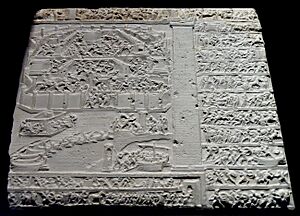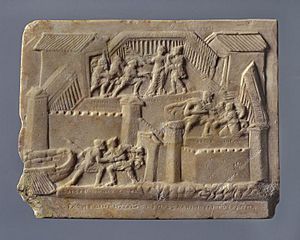Tabulae Iliacae facts for kids
The Tabulae Iliacae (say "Tah-boo-lay Ill-ee-ah-kay") are ancient stone tablets, mostly made of marble. These tablets have cool pictures carved into them, called reliefs. They show scenes from famous Greek epic poetry, especially stories from the Iliad and the exciting Trojan War. These tablets were made during the early Roman Empire, and historians think they came from different workshops in Rome.
Contents
What are the Tabulae Iliacae?
The Tabulae Iliacae are usually small marble panels with very low relief carvings. Imagine tiny pictures carved into stone! These pictures often have labels explaining what's happening. They also have short texts engraved on them.
We don't know their exact sizes because none of them are completely whole today. However, the largest rectangular tablet found so far is about 25 centimeters by 42 centimeters. That's roughly the size of a small laptop screen.
Stories on the Tablets
Many of the scenes on these tablets come from the Epic Cycle. This was a collection of ancient Greek poems that told the whole story of the Trojan War, from beginning to end.
- Eleven of these small marble tablets show pictures of the Trojan War.
- Some even show parts of the Shield of Achilles, which is a famous shield described in the Iliad.
- Another six panels show the dramatic moment when the city of Ilium (also known as Troy) was captured and destroyed.
The Tabula Iliaca Capitolina
One of the most complete and famous examples of these tablets is the Tabula Iliaca Capitolina. It was found near Rome, in a place called Bovillae.
This tablet was made around 15 BCE, during the time of the Roman Emperor Augustus. The carvings on it show many different scenes from the Trojan War. They even have captions to help you understand what's happening.
Aeneas's Journey
One interesting scene on the Tabula Iliaca Capitolina shows Aeneas getting onto a ship after Troy was destroyed. Aeneas was a Trojan hero who later traveled to Italy and became an important figure in Roman myths.
The caption on the carving says this scene is from a poem by Stesichorus, who lived in the 6th century BCE. However, experts have debated for a long time whether this is truly accurate.
Today, the Tabula Iliaca Capitolina is kept in the Capitoline Museums in Rome, where people can still see this amazing ancient artwork.



